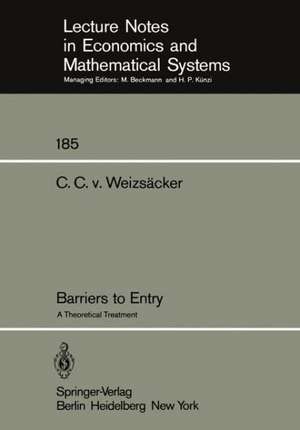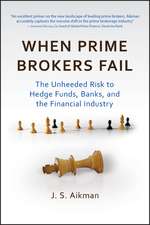Barriers to Entry: A Theoretical Treatment: Lecture Notes in Economics and Mathematical Systems, cartea 185
Autor C. C. v. Weizsäckeren Limba Engleză Paperback – noi 1980
Din seria Lecture Notes in Economics and Mathematical Systems
-
 Preț: 360.02 lei
Preț: 360.02 lei -
 Preț: 383.93 lei
Preț: 383.93 lei -
 Preț: 384.09 lei
Preț: 384.09 lei -
 Preț: 380.07 lei
Preț: 380.07 lei -
 Preț: 446.26 lei
Preț: 446.26 lei -
 Preț: 497.37 lei
Preț: 497.37 lei -
 Preț: 380.84 lei
Preț: 380.84 lei -
 Preț: 384.86 lei
Preț: 384.86 lei -
 Preț: 378.34 lei
Preț: 378.34 lei -
 Preț: 399.67 lei
Preț: 399.67 lei - 20%
 Preț: 360.93 lei
Preț: 360.93 lei - 15%
 Preț: 643.16 lei
Preț: 643.16 lei -
 Preț: 379.09 lei
Preț: 379.09 lei -
 Preț: 404.74 lei
Preț: 404.74 lei -
 Preț: 385.62 lei
Preț: 385.62 lei - 15%
 Preț: 644.49 lei
Preț: 644.49 lei -
 Preț: 379.09 lei
Preț: 379.09 lei -
 Preț: 345.50 lei
Preț: 345.50 lei -
 Preț: 425.80 lei
Preț: 425.80 lei -
 Preț: 378.34 lei
Preț: 378.34 lei - 18%
 Preț: 775.65 lei
Preț: 775.65 lei -
 Preț: 392.60 lei
Preț: 392.60 lei -
 Preț: 401.61 lei
Preț: 401.61 lei - 15%
 Preț: 646.43 lei
Preț: 646.43 lei -
 Preț: 382.18 lei
Preț: 382.18 lei -
 Preț: 378.34 lei
Preț: 378.34 lei - 15%
 Preț: 637.59 lei
Preț: 637.59 lei - 15%
 Preț: 647.27 lei
Preț: 647.27 lei -
 Preț: 377.73 lei
Preț: 377.73 lei -
 Preț: 447.84 lei
Preț: 447.84 lei - 15%
 Preț: 644.49 lei
Preț: 644.49 lei -
 Preț: 386.00 lei
Preț: 386.00 lei - 15%
 Preț: 654.43 lei
Preț: 654.43 lei -
 Preț: 415.02 lei
Preț: 415.02 lei -
 Preț: 411.54 lei
Preț: 411.54 lei -
 Preț: 398.92 lei
Preț: 398.92 lei -
 Preț: 398.92 lei
Preț: 398.92 lei -
 Preț: 392.75 lei
Preț: 392.75 lei - 15%
 Preț: 635.47 lei
Preț: 635.47 lei - 20%
 Preț: 653.56 lei
Preț: 653.56 lei -
 Preț: 379.86 lei
Preț: 379.86 lei -
 Preț: 495.46 lei
Preț: 495.46 lei -
 Preț: 447.99 lei
Preț: 447.99 lei -
 Preț: 378.71 lei
Preț: 378.71 lei - 15%
 Preț: 637.13 lei
Preț: 637.13 lei -
 Preț: 385.84 lei
Preț: 385.84 lei -
 Preț: 378.54 lei
Preț: 378.54 lei - 15%
 Preț: 666.55 lei
Preț: 666.55 lei -
 Preț: 380.07 lei
Preț: 380.07 lei
Preț: 386.39 lei
Nou
Puncte Express: 580
Preț estimativ în valută:
73.93€ • 77.19$ • 61.19£
73.93€ • 77.19$ • 61.19£
Carte tipărită la comandă
Livrare economică 04-18 aprilie
Preluare comenzi: 021 569.72.76
Specificații
ISBN-13: 9783540102724
ISBN-10: 3540102728
Pagini: 232
Ilustrații: VI, 224 p.
Dimensiuni: 170 x 244 x 12 mm
Greutate: 0.38 kg
Editura: Springer Berlin, Heidelberg
Colecția Springer
Seria Lecture Notes in Economics and Mathematical Systems
Locul publicării:Berlin, Heidelberg, Germany
ISBN-10: 3540102728
Pagini: 232
Ilustrații: VI, 224 p.
Dimensiuni: 170 x 244 x 12 mm
Greutate: 0.38 kg
Editura: Springer Berlin, Heidelberg
Colecția Springer
Seria Lecture Notes in Economics and Mathematical Systems
Locul publicării:Berlin, Heidelberg, Germany
Public țintă
ResearchCuprins
1 The General Theoretical Framework.- 1. The Three Levels of Competition.- 2. Barriers to Entry and Externalities.- 3. Entry Deterring Strategies.- 4. Measuring Entry Barriers.- 5. Multidimensionality of Entry.- 6. Policy Implications of the Concept.- 2 Absolute Cost Advantages and Barriers to Entry.- 1. Superior Efficiency.- 2. Patent Rights as Cost Advantages.- 3. Cost Advantages due to Ownership of Scarce Resources.- 4. Conclusion.- 3 Economies of Scale without Intertemporal Links.- 4 Economies of Scale with Intertemporal Links.- 5 Product Differentiation: Goodwill I: The Basic Model.- 1. The Extrapolation Principle.- 2. A Model of Goodwill.- 3. The Meaning of Rational Expectations and the Extrapolation Principle.- 6 Product Differentiation: Goodwill II: Informational Activities.- 1. Efforts to Provide Quality Information (Signalling).- 2. Bias Against Newcomers.- 3. Product Testing.- 4. Economies of Scale due to Goodwill.- 5. Conclusion.- 7 Capital Requirements and Barriers to Entry.- 1. Risk without Moral Hazard.- 2. Asymmetric Information as a Distortion of Entry in the Presence of Risk.- 3. Implications for Capital Requirements as Entry Barriers.- 8 Barriers to Entry in Progressive Industries I: Strictly Sequential Innovations.- 1. The Three Level Framework as a Basis to Study the Relation of Entry Barriers and Technical Progress.- 2. A Simple Model with Strictly Sequential Innovation Structure. The Case of a Strictly Stationary Environment.- 3. The Influence of Market Size and Market Growth.- 4. The Influence of the Degree of Progressiveness and of the Price Elasticity of Demand.- 9 Barriers to Entry in Progressive Industries II: Competing Innovations.- 1. The Equilibrium and the Optimum Number of Competing Innovations for a Given Timing of Innovations.- 2. TheTiming of Competing Innovations.- 3. The Equilibrium: Comparative Static Analysis.- 4. The Optimum.- 5. Evaluation.- 6. Some Policy Implications.- 10 Conclusion.- References.

















